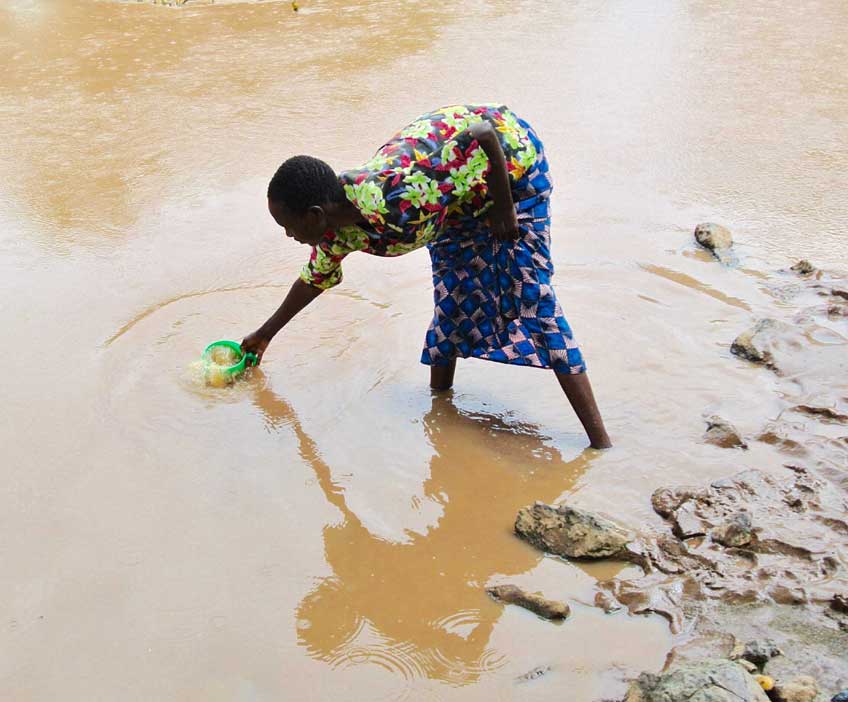Village Voices International is on a mission to help
vulnerable people in rural East Africa improve their quality of life
Join us as we work to…..
Almost half a billion people in sub-Saharan Africa are living in extreme poverty. In rural villages in Kenya where we focus our efforts, the situation is dire for tens of millions.
But these are just numbers.
Let’s look at life through their eyes…
Sign Up For Our Newsletter
Our Approach
It’s not about projects… It’s about people
Village Voices uses a grass-roots approach when partnering with rural communities in East Africa.
We facilitate processes that empower local people to prioritize their needs and make choices about what incremental changes could best improve the quality of their lives.
They are grateful to have a platform to have their voices heard.
Village Voices provides the technical and training resources necessary for villagers to implement and sustain community-led initiatives designed to promote self-sufficiency.
Our decisions are guided by the principle of Helping People Help Themselves – One Village At A Time.
Our activities revolve around the incremental change model Dream – Achieve – Celebrate.
DREAM
“When we dream alone it is only a dream, but when many dream together it is the beginning of a new reality.“
F. Hundertwasser
ACHIEVE
“When spiders unite they can tie up a lion.”
East African Wise Woman
CELEBRATE
“It always seems impossible until it’s done.”
Nelson Mandela
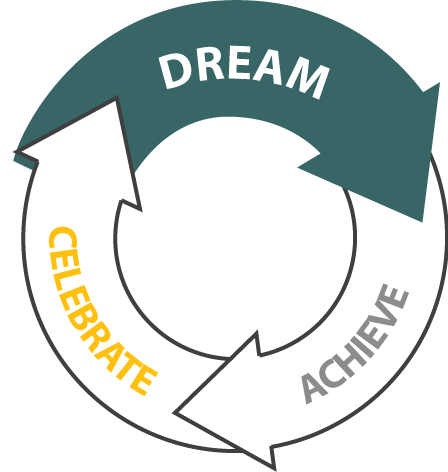
The first, and most important, step for successful community transformation is listening to the voices of the people as they share their stories and visions for a better future. The local people know best what they need and what might work within their unique environment. It’s their dreams that will serve as the catalyst for building stronger communities. Read more…
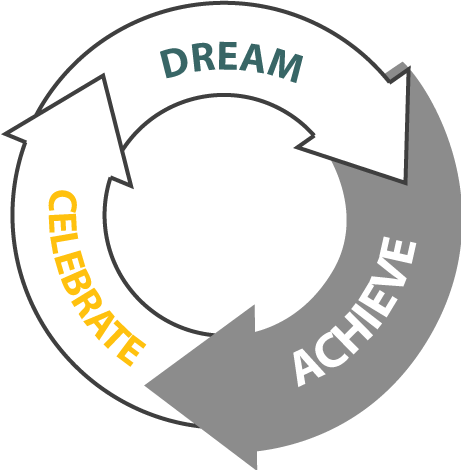
People living in rural villages want to lift themselves from poverty and take care of their families with dignity and cultural pride. They’re strong, resilient and courageous; rich in ideas and accustomed to working together to survive. But they don’t have access to resources for jump-starting change. Village Voices helps them bridge the gap between what is available and what is possible. Read more…
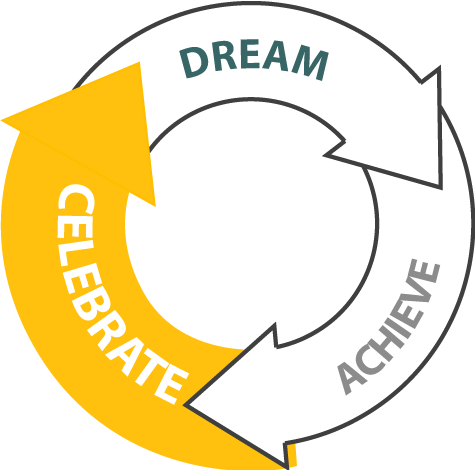
Celebrating the achievement of small and large goals and each person’s contribution to the collective effort is an important part of our community transformation model. We rejoice in the successes that help the villagers envision new goals, and we honor our “less-than” successful efforts as learning opportunities. Thus, the dream, achieve, celebrate cycle for building a stronger community begins anew. Read more…
Voices from the village of Kailer, Kenya
Stories that inspired us to action
HAVING TIME: Everlyne's Dream
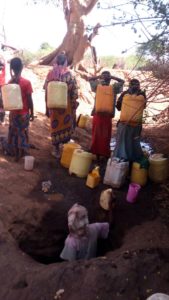 Everlyne will walk over 6 miles to the river today, spending 7 hours fetching water for her family – even more during the dry season when she must wait in a queue to climb into a hand-dug well to fill her 20-liter jerry can. She makes this trip several times every day because she can only carry 40 pounds of water strapped to her forehead at a time. This will barely be enough for cooking and drinking for the day. There’s no time for rest. Everlyn is exhausted from collecting water, in addition to her other household chores like searching for firewood, preparing food and caring for her children. She must compete with swarms of bees that also come to the river in search of water during the dry season. Her hands are sore and swollen from their stings. Her dream is to be free from fetching so she has the time to contribute to her family’s needs in other ways – such as participating in a women’s co-op for bee-keeping. The sale of honey would provide school fees for her children.
Everlyne will walk over 6 miles to the river today, spending 7 hours fetching water for her family – even more during the dry season when she must wait in a queue to climb into a hand-dug well to fill her 20-liter jerry can. She makes this trip several times every day because she can only carry 40 pounds of water strapped to her forehead at a time. This will barely be enough for cooking and drinking for the day. There’s no time for rest. Everlyn is exhausted from collecting water, in addition to her other household chores like searching for firewood, preparing food and caring for her children. She must compete with swarms of bees that also come to the river in search of water during the dry season. Her hands are sore and swollen from their stings. Her dream is to be free from fetching so she has the time to contribute to her family’s needs in other ways – such as participating in a women’s co-op for bee-keeping. The sale of honey would provide school fees for her children.
Experience Everlyne’s Day in the video to the right.
CLEAN WATER AND NO SNAKES: Sanantei's Hope
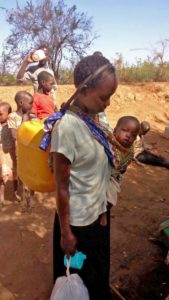 Sanantei had to drop out of primary school to help her mother with chores. As is sometimes the custom when a girl is no longer in school, she was placed in an arranged marriage by her father in exchange for a dowry of goats that will help provide for his younger children. Sanantei now has a small baby to care for and household chores of her own. Because she is afraid of snakes and hyenas, she runs to the river to fetch water – but she must walk home due to the weight of the jerry can on her back and the child tied to her chest. She fills a zippy cup with contaminated river water that smells of cow’s urine. She is only vaguely aware that this water could be the cause of her baby’s chronic diarrhea. She’s not able to breast-feed because she is undernourished herself and not producing milk. Sanantei hopes her girl child will be well soon, and she hopes she won’t encounter a poisonous black mamba snake during her 2-mile journey home.
Sanantei had to drop out of primary school to help her mother with chores. As is sometimes the custom when a girl is no longer in school, she was placed in an arranged marriage by her father in exchange for a dowry of goats that will help provide for his younger children. Sanantei now has a small baby to care for and household chores of her own. Because she is afraid of snakes and hyenas, she runs to the river to fetch water – but she must walk home due to the weight of the jerry can on her back and the child tied to her chest. She fills a zippy cup with contaminated river water that smells of cow’s urine. She is only vaguely aware that this water could be the cause of her baby’s chronic diarrhea. She’s not able to breast-feed because she is undernourished herself and not producing milk. Sanantei hopes her girl child will be well soon, and she hopes she won’t encounter a poisonous black mamba snake during her 2-mile journey home.
CLICK ON Learn More below TO SEE WHAT’S BEEN ACHIEVED FOR SANANTEI’s DREAM OF NO FETCHING!
TRIBAL MEDICINE - A DYING ART: Noinkunyihi's Contribution
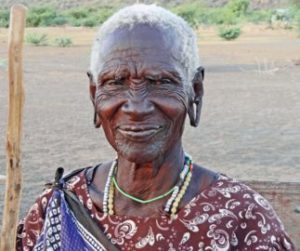 Noinkunyiyi is mid-wife and healer for the people living in Kailer. She has served as the only healthcare provider many villagers have ever known. Without roads or transportation, it’s impossible for those who are ill or in labor to walk in the tropical heat to the nearest clinic 11 miles away. So they rely on Noinkunyiyi for her traditional medicine and birthing care, considering her their doctor. She’s the oldest person in the village, having lived over 90 years, they guess. There are no birth records for the Ilchamus people. She never went to school, can’t read or write and only speaks Maa, her tribal language, but Noinkunyiyi is respected as the expert in ancient remedies and healing rituals. Because rural villages rely on trees as their only source for fuel, the herbs, leaves, bark and pods that she uses as medicine are disappearing; and the sharing of traditional ways from generation to generation is dying along with the elderly. When Noinkunyiyi passes, this will be the case in Kailer. Without easy access to modern medicine, the villagers will be vulnerable to the complications of home births and illnesses previously treated by their wise-woman healer.
Noinkunyiyi is mid-wife and healer for the people living in Kailer. She has served as the only healthcare provider many villagers have ever known. Without roads or transportation, it’s impossible for those who are ill or in labor to walk in the tropical heat to the nearest clinic 11 miles away. So they rely on Noinkunyiyi for her traditional medicine and birthing care, considering her their doctor. She’s the oldest person in the village, having lived over 90 years, they guess. There are no birth records for the Ilchamus people. She never went to school, can’t read or write and only speaks Maa, her tribal language, but Noinkunyiyi is respected as the expert in ancient remedies and healing rituals. Because rural villages rely on trees as their only source for fuel, the herbs, leaves, bark and pods that she uses as medicine are disappearing; and the sharing of traditional ways from generation to generation is dying along with the elderly. When Noinkunyiyi passes, this will be the case in Kailer. Without easy access to modern medicine, the villagers will be vulnerable to the complications of home births and illnesses previously treated by their wise-woman healer.
CLICK ON Learn More below TO SEE THE PROGRESS on IMPROVING ACCESS TO HEALTHCARE!
FOOD INSECURITY AND KITCHEN GARDENS: Esther's Story
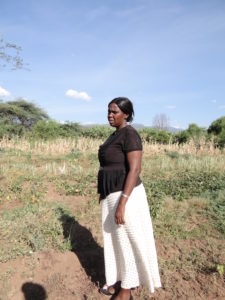 Esther came to our first focus group with a plan and a stick for drawing her dream in the sandy soil – farm ponds to irrigate crops in kitchen gardens. As a child, Esther loved going to school – learning new things and having big ideas. But she had to drop out at age 13 when she was given to an older man in an arranged marriage. Her situation and the five children that followed didn’t diminish her innate sense that women are capable of doing more to contribute to the community than their traditional gender roles. Esther grew to be strong and assertive, believing a woman’s influence is as important as a man’s authority. After her 5th child, she insisted on going to a tech school to learn to sew with the dream of starting a women’s co-op someday – teaching others to sew school uniforms. She did just that. But there’s no time to pursue entrepreneurial activities. Her immediate concern is lack of food. She began the “Kitchen Garden Women’s Group” to share ideas for dry farming. She’s tried growing mangos as a demonstration project; she hand-tills and plants a subsistence garden for her family’s food. But every attempt at cultivation has been thwarted by lack of water during the dry season. This forces her to spend what little money is available to purchase food from others- barely enough to meet her children’s daily needs. It is a financial struggle to keep her daughters in school. She relies on selling goats for fees, but the livestock are dying from the drought. Nevertheless, Esther’s dream of overcoming food insecurity remains alive as does her dream of teaching tailoring skills to empower other women in her community. But it all depends on having access to water.
Esther came to our first focus group with a plan and a stick for drawing her dream in the sandy soil – farm ponds to irrigate crops in kitchen gardens. As a child, Esther loved going to school – learning new things and having big ideas. But she had to drop out at age 13 when she was given to an older man in an arranged marriage. Her situation and the five children that followed didn’t diminish her innate sense that women are capable of doing more to contribute to the community than their traditional gender roles. Esther grew to be strong and assertive, believing a woman’s influence is as important as a man’s authority. After her 5th child, she insisted on going to a tech school to learn to sew with the dream of starting a women’s co-op someday – teaching others to sew school uniforms. She did just that. But there’s no time to pursue entrepreneurial activities. Her immediate concern is lack of food. She began the “Kitchen Garden Women’s Group” to share ideas for dry farming. She’s tried growing mangos as a demonstration project; she hand-tills and plants a subsistence garden for her family’s food. But every attempt at cultivation has been thwarted by lack of water during the dry season. This forces her to spend what little money is available to purchase food from others- barely enough to meet her children’s daily needs. It is a financial struggle to keep her daughters in school. She relies on selling goats for fees, but the livestock are dying from the drought. Nevertheless, Esther’s dream of overcoming food insecurity remains alive as does her dream of teaching tailoring skills to empower other women in her community. But it all depends on having access to water.
CLICK ON Learn More below TO SEE WHAT’S BEEN ACHIEVED TO MAKE ESTHER’S DREAM OF FOOD SECURITY COME TRUE!
A DISAPPEARING WAY OF LIFE: Sameri and Loriwo's Dilemma
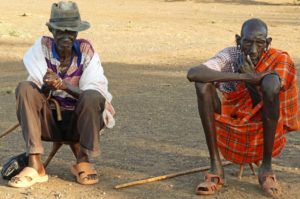 Since they were boys, Sam and Lori have risen at dawn to look for water and grass for their livestock. In the dry season, they used to set up cattle camps with other herders far from their homesteads, sharing a water hole with thirst-starved wildlife. When their children were young, they would pour goats’ milk into cowhide flasks and run it back to the village, maybe 10 miles away, so their kids could have nourishment – then run back to the camp each night. For centuries, daily life for Ilchamus women and men has been centered around finding water. Sam and Lori never had formal schooling, but each acquired over the years an intimate knowledge of the land and weather patterns that dictate pastoral life. Now they are seeing changes. Where once there was open savannah for grazing, now there are fences and privatized water rights. The familiar rhythm of the rainy and dry seasons is gone. They wouldn’t recognize the term climate change, but they know the rain is no longer predictable and does not last long enough to relieve the drought. The livestock are dying. Their skimpy maize crops are dying. The people are hungry. Sam and Lori instinctively know the community cannot sustain itself in the old tradition, but they do not know how the youth of the village can turn to a new livelihood without different skills and above all – water. CLICK ON Learn More below TO SEE THE PROGRESS BEING MADE TO ENHANCE LIVELIHOODS THROUGH SKILLS TRAINING!
Since they were boys, Sam and Lori have risen at dawn to look for water and grass for their livestock. In the dry season, they used to set up cattle camps with other herders far from their homesteads, sharing a water hole with thirst-starved wildlife. When their children were young, they would pour goats’ milk into cowhide flasks and run it back to the village, maybe 10 miles away, so their kids could have nourishment – then run back to the camp each night. For centuries, daily life for Ilchamus women and men has been centered around finding water. Sam and Lori never had formal schooling, but each acquired over the years an intimate knowledge of the land and weather patterns that dictate pastoral life. Now they are seeing changes. Where once there was open savannah for grazing, now there are fences and privatized water rights. The familiar rhythm of the rainy and dry seasons is gone. They wouldn’t recognize the term climate change, but they know the rain is no longer predictable and does not last long enough to relieve the drought. The livestock are dying. Their skimpy maize crops are dying. The people are hungry. Sam and Lori instinctively know the community cannot sustain itself in the old tradition, but they do not know how the youth of the village can turn to a new livelihood without different skills and above all – water. CLICK ON Learn More below TO SEE THE PROGRESS BEING MADE TO ENHANCE LIVELIHOODS THROUGH SKILLS TRAINING!
Everlyne’s Day

